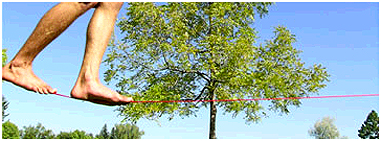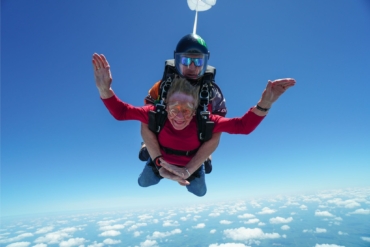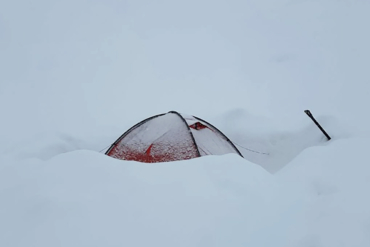Step off the ground. Look forward. Breathe.
Those were Sam Salwei’s sole instructions last fall when I stepped barefoot onto a span of inch-wide nylon webbing, its elevated length pulled tight and reverberating like a big guitar string hung 4 feet above the ground.
The line creaked with my weight. Arms shot out, searching for balance. Toes curled on the loaded line before — SNAP! — my foot slipped off, and I was flying.

Paul Cassedy on a line; Photo by Freesolo Photography/Sean O’Connor
We were in Minneapolis at the University of Minnesota, where slacklining is practiced between tall oak trees on a grassy mall. Like its cousin sport of tightrope walking, slacklining requires focus and acute balance to walk thin pathways through the air.
But slacklining is practiced on webbing with stretch, a taut line with some give, more akin to a rubber band than a cable. Most slacklines are set 20 to 40 feet long, tied between trees and hovering just a few feet off the ground. And the activity, invented in the 1970s by California rock climbers as a training regimen to boost concentration and balance, is less a circus act than it is a Zen discipline, mind and body working together in an elusive search for equilibrium.
Long a fringe activity, slacklining has grown in the past couple years, with gymnasts, yogis, cyclists, kayakers and even some soccer players embracing the sport, according to Joe Kuster, a climber who started Slackline Express LLC as a student at Missouri State University. “We’ve now sold slackline kits to the U.S. gymnastics team, physical rehabilitation clinics and the New Orleans Saints football team,” he said.
Slackline Express, based in Lafayette, Colo., offers packages with webbing, ratchets, carabiners, pads and slings — all you need to set up a line in your back yard — starting at $40.

footwork is half the game
Kuster has sold kits and supplies for about 8,000 setups since 2003. Sales have tripled in each of the past three years, he said.
Ric Phiegh, a 50-year-old pioneer of the sport, said slacklining is going mainstream. “Used to be I could count all the slackers in the country on two hands,” said Phiegh, who eight years ago started Slackline Brothers Inc. with his wife, Maria, in Los Angeles. “Today we’re seeing interest from surfers, skaters and snowboarders,” he said. “Parents call me every week for their kids, who saw a slackline at a festival or on a college campus.”
YogaSlackers.com sells its instructional DVD, “Slackasana,” for $24.95, as well as a Slackline Kit, which includes webbing, a pose guide, carabiners, instructions for assembly, and a bag made from recycled materials. It costs $75. Both products are available at https://www.adicarter.com/slackasana.html.
A new company, Gibbon Slacklines (www.gibbonslacklines.com) sells a kit made for beginners. It includes two pieces of webbing and a ratcheting tensioner for quick setup. Gibbon’s webbing is 50mm wide — twice the width as common slackline webbing — making balance easier.

Gibbon Slacklines’ kit
As a physical feat, slacklining engages almost every muscle in the body — feet, legs, arms and core — and requires constant minute adjustments to keep balance. Learning how to make just a few controlled steps can take hours or days of practice as muscles, mind and inner ear team up to defy gravity on a bouncing, stretching, swinging line.
“It’s meditative,” said Kathryn Joyce, a 22-year-old philosophy major from the University of North Dakota, who was visiting Minneapolis with Salwei. “I forget about everything on a slackline,” she said.
Slackers traverse the line from foot to foot, pausing to balance with each step, breathing consciously and staring straight ahead, toes feeling the flat webbing below. Their arms flag out. Legs swing to counterweight. Eyes glaze deep with concentration and will.
“It puts me into a zone quicker than yoga, quicker than anything,” said Salwei, a yoga instructor who incorporates poses — “yogaslacking,” as he calls it — into his slacklining sessions. (Salwei runs www.yogaslackers.com, a site devoted to the burgeoning subgenre.)

open water slacking
For Ryan Olson, a student of theoretical chemistry, slacklining is less about metaphysics, more about fun. “I learned this sport at barbecues, just hanging out with friends, looking for something to do,” he said.
On the lawn at the University of Minnesota — where Olson, Salwei and Joyce shared a slackline for two hours — people walking past couldn’t help but stop. The golden webbing, strung 4 feet high and stretching 70 feet between trees, glinted in a patch of sun.
Olson secured the webbing with carabiners and small metal rappel rings, cinching the setup until it twanged. “Shall we?” he said, motioning toward the line.
Salwei stepped on, bouncing up on one foot, arms swinging out, then standing straight. “Do a trick,” a student yelled.
But Salwei sat down instead, easing back onto the line, crossing his legs in the lotus position, levitating but for a strip of thin nylon under his seat.
He stretched back up, feet sliding catlike on air. Back muscles flexed through his shirt. “This is Virabhadrasana,” he said, arms raising into the yogic warrior pose.

Virabhadrasana pose on a slackline
Joyce and Olson were more subdued, pacing during their turns, maintaining for 2 minutes or more, bouncing a bit, spinning at the end of the line, then heading back.
For beginners like me — I’ve been on a slackline a half-dozen times — simply standing up and staying calm is the main challenge. My procedure generally goes like this:
1. Approach the line.
2. Breathe.
3. Put left foot on line.
4. Leap up, balancing on left leg.
5. Stare ahead. (Forget to breathe.)
6. Swing arms and right leg wildly.
— SNAP! —
7. Tumble to the ground.
But by the end of the session at the University, some of Salwei and crew’s slack vibe was rubbing off. I stood straight up on the line and relaxed, now in the shade, no one else around. “You got it, man,” Olson said.
The webbing quaked underfoot, its every fiber squeaking, protesting my weight. I stepped forward, switching feet. Readjusting balance. Breathing.
Six steps later, deliberate, slow and balanced, I was still standing.
Then my foot slipped. The line snapped up, stinging skin on the rebound, gravity winning one more time.
I stood up and walked toward the line. Salwei was leaning against a tree, waiting to walk again. “Just give me one more try,” I said.
—Stephen Regenold writes a daily blog on outdoors gear at www.gearjunkie.com.






